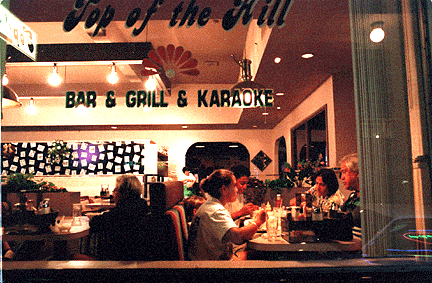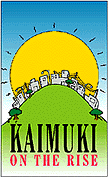
Nightlife at the Top of the Hill restaurant in Kaimuki
shows the way for the area's rejuvenation.
Photo by Kathryn Bender, Star-Bulletin

Nightlife at the Top of the Hill restaurant in Kaimuki
shows the way for the area's rejuvenation.
Photo by Kathryn Bender, Star-Bulletin
But with Waialae Avenue serving as the main connector between downtown and East Honolulu, Kaimuki became a major shopping district. The annual Kaimuki Christmas parade, begun in 1946, signaled the start of the Christmas season and people would come from miles to take in the yuletide lights and decorations paid for by businesses to festoon the town's main street.
The coming of the H-1 Freeway and changing shopping habits would dramatically diminish its importance, and for years, Kaimuki has had the musty look of a town that has seen better days. But two years away from celebrating its 100th birthday, Kaimuki seems to be in a period of rejuvenation, with town leaders hoping that mainstay businesses, together with young entrepreneurs, will be able to restore the area to its shopping heyday.
 A little history: Most of the area known as Kaimuki, about 324 acres, was given to William Lunalilo by Kamehameha III in 1848. It sold for $2,325 in 1884 to Daniel Paul Isenberg, who would go on to become a territorial senator. Combined with what his father owned, Isenberg's property stretched roughly from Kapahulu Avenue to Kahala Beach.
A little history: Most of the area known as Kaimuki, about 324 acres, was given to William Lunalilo by Kamehameha III in 1848. It sold for $2,325 in 1884 to Daniel Paul Isenberg, who would go on to become a territorial senator. Combined with what his father owned, Isenberg's property stretched roughly from Kapahulu Avenue to Kahala Beach.
In 1898, Isenberg sold about 520 acres to Gear Lansing & Co., one of Honolulu's first real estate firms, for $20,000. The company envisioned Kaimuki becoming a high-class residential area, but was stymied by buyers' lack of interest.
What helped save the developers was the Chinatown fire of 1900, which left a lot of small businessmen in need of a new place to live and work. Another boon was the extension of the streetcar line up at Waialae, from Kapahulu to Koko Head Avenue, in 1903.
The business district began to develop after 1925, when the dirt roads were paved and sidewalks were laid. Then in the '60s, the H-1 Freeway was built, cutting a massive swath through the residential neighborhood.
It was only through intense lobbying by the Kaimuki Business and Professional Association that officials agreed to build a Kaimuki off-ramp, said KBPA president Randall Ikawa.
Still, motorists could now bypass the town and many businesses never recovered from the loss of passersby.
But, there is a positive spin to the H-1, said Kathryn Pon, whose father-in-law, Joe Shoong, founded the National Dollar chain of stores. The family owns the Kaimuki property where the Rattan Art Gallery sat for years and which the Salvation Army now leases.
"The deterioration of the retail climate has helped to save the historic nature of Kaimuki," Pon said, because "it meant that new businesses didn't move in at quite the rate that might be expected (and) landlords didn't update."
"That means there is a base now of interesting pedestrian-type storefronts that can become a
draw for the whole community as a sort of preserved area, a walking district," she said.
Steve Sofos, of Sofos Realty, agreed, pointing also to municipal parking lots that were built to help businesses survive. Those lots have turned out to be both "a blessing and a curse," he said.
"The lots allowed businesses to keep what they've got, renovating rather than tearing down and increasing the density (by going high-rise)," Sofos said. "But it's also been a curse, because Kaimuki has not doubled or tripled in values because of that."
From his perch on a bench at Kaimuki AA Taxi on 12th Avenue, Eddie Uyehara, 57, a limo driver, observed, "All you have now is banks and restaurants."
The former town anchors - Kress, National Dollar, Ben Franklin, Thrifty Drugs - are all gone. So are a host of smaller stores that Alfred Tam, owner of the taxi stand, remembers.
"Kaimuki before had a lot of supermarkets. No more any now," he said, dismissing Times Supermarket at the lower end of Waialae as not really being Kaimuki. "This is the center of Kaimuki," Tam, 88, proclaimed, noting the area from about 9th to Koko Head avenues.
Even son Benjamin Tam, 60, observed acridly, "I watch business decline from greatness to nothing. Kaimuki is now a ghost town."
But, others have a less dyspeptic view of Kaimuki in the '90s.
Where the 46-year-old Thrifty Drugs closed last October sits Payless ShoeSource, the 18th and most recent of the national chain's Hawaii outlets.
"A lot of research" showed that Kaimuki was "one of the best areas to go with," said Kaimuki manager Ray Bajcar. Customers "pay cash here. There are a lot of charges, as well," he said. "People here are, for the most part, established" and business is steady.
Financial institutions have long known Kaimuki "is a good base for deposits," said Darrick
Ching, manager of the Kaimuki Bank of Hawaii, the first bank to move into the neighborhood 54 years ago. Today, there are 13 different institutions with 15 branches there.
"Our market is known for high-deposit customers, for personal banking," rather than commercial or small-business accounts, said Ching.
Kaimuki is a stable neighborhood, Sofos agreed. For him, that translates to "not a dynamic area." Recently, the CPB and Napa buildings showed up on Waialae and there has been some renovation, "but that's been it as far as redevelopment," he said. "I don't foresee any major new development going on."
(A proposed multi-family elderly rental housing project on Sierra Drive is making its way through community and government channels.)
What continues to attract businesses are comparatively steady rents, traditionally lower than downtown or Kapiolani Boulevard, Sofos said.
Glenn Harada, of Coffee Time Cafe, said "rents are going up, but it's cheaper than Pearl City or Mililani, where I live."
Still, Sofos said, "You can rent something for $2.25 a square foot today and in five years, it'll probably be the same."
The Related Story:
Kaimuki businesses [Finding Their Niche]